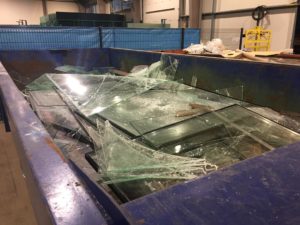Reducing its carbon footprint has become a priority for the flat glass industry, especially by increasing its recyclable content.
In fact, increasing its glass cullet rate (broken glass) in its glass production allows not only to limit its raw material consumption such as sand, bus also to reduce significantly its CO2 emissions. By using cullet, you can benefit from two advantages: you will be using less energy for melting glass and this process doesn’t release any CO2.
Righetti : a green company since 10 years

Sustainable development has been one of the major priorities of Righetti. By recycling its glass scraps and its glass wastes, Righetti is taking part to this collective work among glass professionals, they are also developing a more circular economy.
Discover all its partnerships within multiple networks of glass professionals.
Saint-Gobain Glass can be produced with 30% of recycled materials

The Glass Sector of Sain-Gobain is also acting in that direction through its program Glass Forever created in 2017. They are working to increase the scrap rate from processing facilities towards glass furnaces. They are also adapting furnaces so that they can work with more glass cullet.


